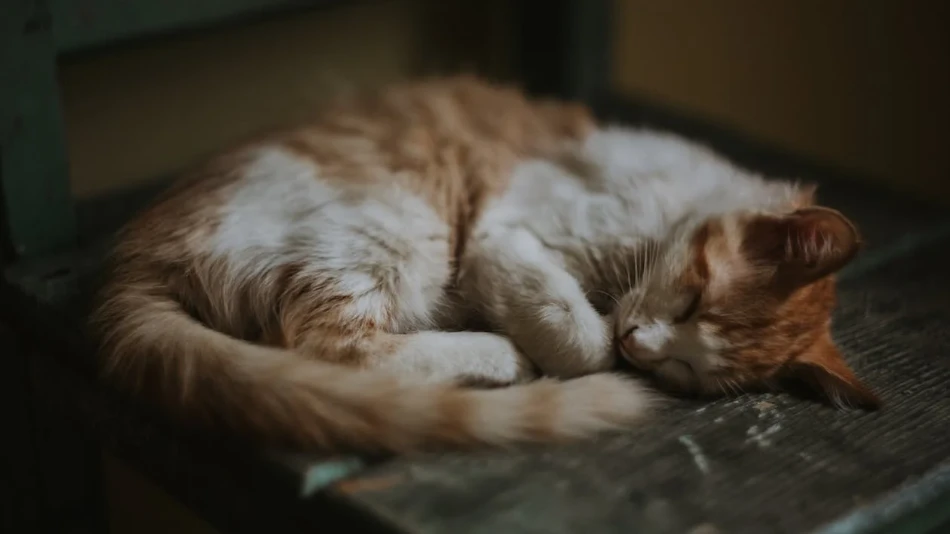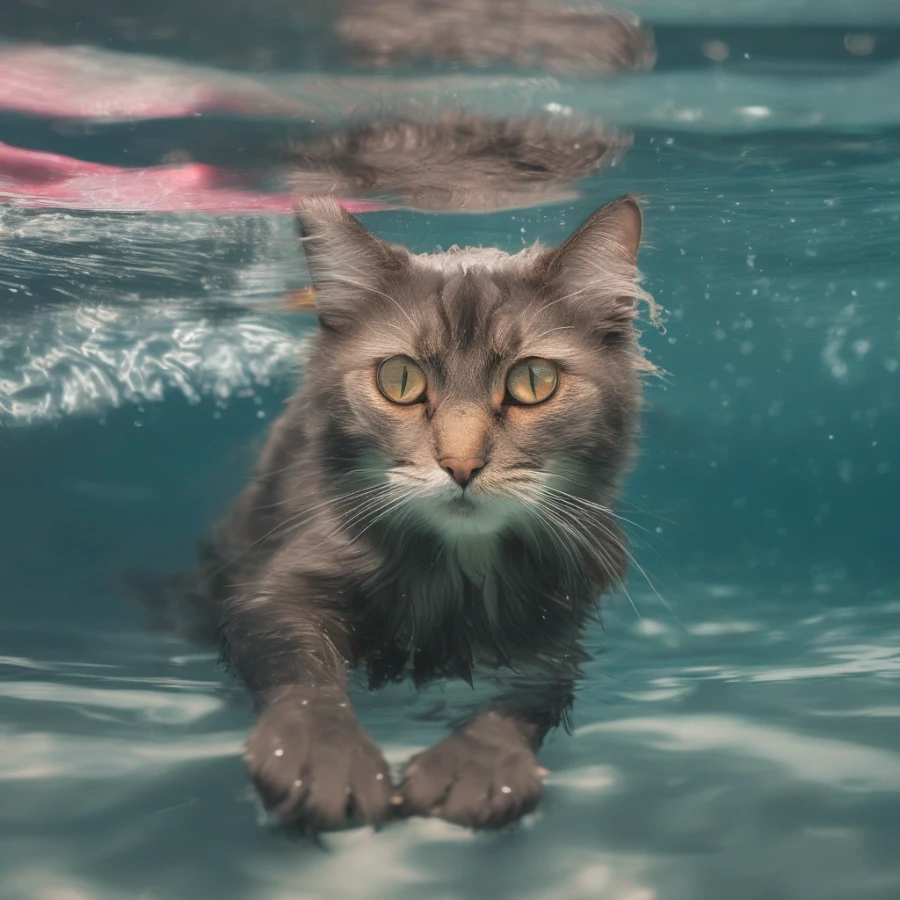Deciphering Cat Tail Language: Why Do Cats Wag Their Tails While Lying Down?

Published by: Tatsiana Korshik
Time to Read: 4 Min

Cats are mysterious creatures, and one of the ways they communicate their thoughts and feelings is through their tails. You've likely observed your feline friend's tail in action, but have you ever wondered why cats sometimes wag their tails while lying down? In this in-depth blog post, we'll explore the fascinating world of cat tail language, uncovering the reasons behind tail movement when cats are at rest. Understanding this behavior can provide valuable insights into your cat's emotions and needs.
Upward Tail: A tail held high is a sign of confidence and contentment. It often indicates a happy and relaxed cat.
Puffed Tail: A puffed-up tail is a clear sign of fear or aggression. It makes the cat appear larger and more intimidating.
Twitching Tail: A twitching tail can be a sign of excitement or anticipation. It often happens when a cat is focused on prey or a toy.
Slow Wagging Tail: Slow, deliberate tail wagging is typically a sign of annoyance or mild agitation. It can be a warning sign that your cat is reaching its limit.
Rapid Tail Movement: Rapid tail movement, like a flicking or vibrating tail, can indicate intense excitement, irritation, or overstimulation.
Dreaming and Playful Behavior Cats often dream during their sleep, and you may notice their tails moving as they react to dream scenarios. These tail movements can mimic hunting or play behaviors, indicating that your cat is engaged in a dream-time adventure.
Response to Environmental Stimuli Cats are highly attuned to their surroundings, even when they're resting. A cat's tail may wag in response to external stimuli, such as the sound of a bird outside the window or the scent of another animal in the vicinity.
Processing Emotions Tail wagging while lying down can also be a way for cats to process emotions or experiences. It might signify a cat working through feelings of anxiety, excitement, or even annoyance.
Communication Cats use their tails to communicate, and this holds true even when they're at rest. Tail movements can signal to other animals or humans in the household, conveying emotions or intentions. For example, a cat may gently wag its tail while lying down as a friendly greeting.
Observe Context: Pay attention to the overall context of your cat's behavior. Is the tail wagging accompanied by other signs of relaxation, playfulness, or agitation?
Look for Other Clues: Alongside tail movement, notice your cat's body posture, facial expressions, and vocalizations to get a complete picture of their emotional state.
Respect Boundaries: If your cat's tail is wagging due to agitation, it's essential to respect their boundaries and avoid further provoking or engaging them.
Provide Enrichment: To keep your cat mentally and physically stimulated, offer toys, playtime, and interactive activities that align with their interests and instincts.
Conclusion In conclusion, the subtle art of cat tail language extends beyond simple wagging while lying down. It's a complex and nuanced form of communication that reflects a cat's emotions, dreams, responses to stimuli, and interactions with their environment. By understanding and respecting your cat's tail language, you can deepen your bond and ensure a harmonious and enjoyable relationship with your feline companion. So the next time you see your cat wagging its tail while lounging, you'll have a better grasp of the rich tapestry of emotions they might be expressing.
Tail wagging while lying down is a common behavior in cats and is entirely normal. It can vary in intensity and frequency among individual cats.
What does it mean if my cat's tail is twitching while they are asleep?
Twitching or slight movements of the tail during sleep are usually associated with dreaming or reacting to dream scenarios. It's similar to how humans might twitch or move slightly during their dreams.
Should I wake my cat if I notice their tail moving during sleep?
It's generally not necessary to wake your cat if you observe tail movement during sleep. Cats need their rest, and interrupting their sleep can be stressful. Let them enjoy their dreams undisturbed.
Can tail wagging while lying down indicate pain or discomfort?
In some cases, yes. If your cat is experiencing pain or discomfort, they may exhibit abnormal tail movements, including excessive twitching or restlessness. If you suspect your cat is in pain, consult your veterinarian.
How can I differentiate between playful tail wagging and agitated tail wagging while my cat is lying down?
Pay attention to your cat's overall body language. Playful tail wagging is often accompanied by a relaxed posture, while agitated tail wagging may involve other signs like flattened ears, dilated pupils, or tense muscles.
My cat's tail wags when they're watching birds outside. Is this normal?
Yes, it's entirely normal. Cats are natural hunters and often exhibit tail movements when they're excited by the sight of potential prey, even if they're indoors.
Should I intervene if my cat's tail is wagging due to environmental stimuli?
It's generally not necessary to intervene unless your cat's behavior becomes excessively agitated or aggressive. Cats often respond to external stimuli, and their tail movements are a way of expressing their excitement or curiosity.
Can I train my cat to communicate better with their tail?
While you can't train your cat to wag their tail on command, you can become more attuned to their tail language through observation. Over time, you'll better understand what your cat's tail movements mean in various situations.
Are there any health concerns associated with tail wagging while lying down?
In most cases, tail wagging while lying down is a normal behavior. However, if you notice any sudden or drastic changes in your cat's tail movements, such as persistent agitation or pain-related behaviors, it's advisable to consult with a veterinarian.
Can cats wag their tails when they are content and relaxed?
Yes, cats can wag their tails when they are content and relaxed. A slow and gentle tail wag, often with the tail held upright, can be a sign of a happy and comfortable
The Complex Language of Cat Tails
Before we delve into the specific behavior of tail wagging while cats are lying down, let's first grasp the basics of cat tail language:Upward Tail: A tail held high is a sign of confidence and contentment. It often indicates a happy and relaxed cat.
Puffed Tail: A puffed-up tail is a clear sign of fear or aggression. It makes the cat appear larger and more intimidating.
Twitching Tail: A twitching tail can be a sign of excitement or anticipation. It often happens when a cat is focused on prey or a toy.
Slow Wagging Tail: Slow, deliberate tail wagging is typically a sign of annoyance or mild agitation. It can be a warning sign that your cat is reaching its limit.
Rapid Tail Movement: Rapid tail movement, like a flicking or vibrating tail, can indicate intense excitement, irritation, or overstimulation.
Why Do Cats Wag Their Tails While Lying Down?
Tail wagging in cats, even when they're lying down, is an intriguing behavior that can convey various emotions and intentions:Dreaming and Playful Behavior Cats often dream during their sleep, and you may notice their tails moving as they react to dream scenarios. These tail movements can mimic hunting or play behaviors, indicating that your cat is engaged in a dream-time adventure.
Response to Environmental Stimuli Cats are highly attuned to their surroundings, even when they're resting. A cat's tail may wag in response to external stimuli, such as the sound of a bird outside the window or the scent of another animal in the vicinity.
Processing Emotions Tail wagging while lying down can also be a way for cats to process emotions or experiences. It might signify a cat working through feelings of anxiety, excitement, or even annoyance.
Communication Cats use their tails to communicate, and this holds true even when they're at rest. Tail movements can signal to other animals or humans in the household, conveying emotions or intentions. For example, a cat may gently wag its tail while lying down as a friendly greeting.
Understanding Your Cat's Tail Language
To better interpret your cat's tail movements, consider the following tips:Observe Context: Pay attention to the overall context of your cat's behavior. Is the tail wagging accompanied by other signs of relaxation, playfulness, or agitation?
Look for Other Clues: Alongside tail movement, notice your cat's body posture, facial expressions, and vocalizations to get a complete picture of their emotional state.
Respect Boundaries: If your cat's tail is wagging due to agitation, it's essential to respect their boundaries and avoid further provoking or engaging them.
Provide Enrichment: To keep your cat mentally and physically stimulated, offer toys, playtime, and interactive activities that align with their interests and instincts.
Conclusion In conclusion, the subtle art of cat tail language extends beyond simple wagging while lying down. It's a complex and nuanced form of communication that reflects a cat's emotions, dreams, responses to stimuli, and interactions with their environment. By understanding and respecting your cat's tail language, you can deepen your bond and ensure a harmonious and enjoyable relationship with your feline companion. So the next time you see your cat wagging its tail while lounging, you'll have a better grasp of the rich tapestry of emotions they might be expressing.
Frequently Asked Questions (FAQs) About Why Do Cats Wag Their Tails While Lying Down
Is tail wagging while lying down normal for all cats?Tail wagging while lying down is a common behavior in cats and is entirely normal. It can vary in intensity and frequency among individual cats.
What does it mean if my cat's tail is twitching while they are asleep?
Twitching or slight movements of the tail during sleep are usually associated with dreaming or reacting to dream scenarios. It's similar to how humans might twitch or move slightly during their dreams.
Should I wake my cat if I notice their tail moving during sleep?
It's generally not necessary to wake your cat if you observe tail movement during sleep. Cats need their rest, and interrupting their sleep can be stressful. Let them enjoy their dreams undisturbed.
Can tail wagging while lying down indicate pain or discomfort?
In some cases, yes. If your cat is experiencing pain or discomfort, they may exhibit abnormal tail movements, including excessive twitching or restlessness. If you suspect your cat is in pain, consult your veterinarian.
How can I differentiate between playful tail wagging and agitated tail wagging while my cat is lying down?
Pay attention to your cat's overall body language. Playful tail wagging is often accompanied by a relaxed posture, while agitated tail wagging may involve other signs like flattened ears, dilated pupils, or tense muscles.
My cat's tail wags when they're watching birds outside. Is this normal?
Yes, it's entirely normal. Cats are natural hunters and often exhibit tail movements when they're excited by the sight of potential prey, even if they're indoors.
Should I intervene if my cat's tail is wagging due to environmental stimuli?
It's generally not necessary to intervene unless your cat's behavior becomes excessively agitated or aggressive. Cats often respond to external stimuli, and their tail movements are a way of expressing their excitement or curiosity.
Can I train my cat to communicate better with their tail?
While you can't train your cat to wag their tail on command, you can become more attuned to their tail language through observation. Over time, you'll better understand what your cat's tail movements mean in various situations.
Are there any health concerns associated with tail wagging while lying down?
In most cases, tail wagging while lying down is a normal behavior. However, if you notice any sudden or drastic changes in your cat's tail movements, such as persistent agitation or pain-related behaviors, it's advisable to consult with a veterinarian.
Can cats wag their tails when they are content and relaxed?
Yes, cats can wag their tails when they are content and relaxed. A slow and gentle tail wag, often with the tail held upright, can be a sign of a happy and comfortable



